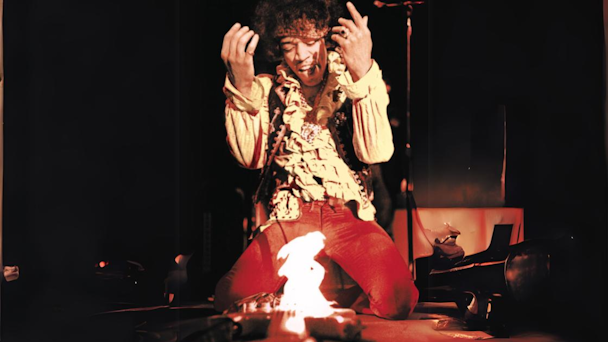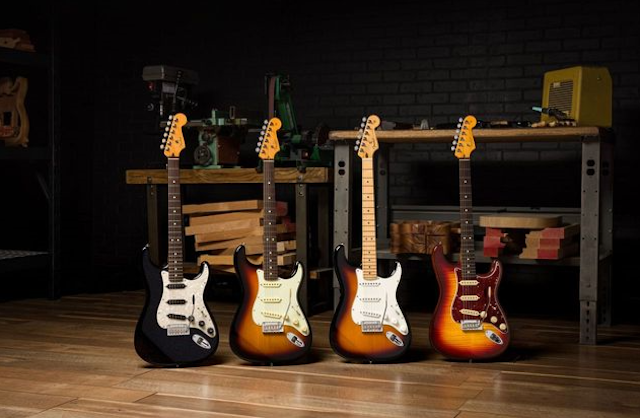The Stratocaster is 70. Fender’s CMO believes Jimi Hendrix is key to the next 70
Fender CMO Evan Jones reveals how the guitar brand is channeling Jimi Hendrix to help attract the next generation of Voodoo Children, showcasing how he has modernized its marketing department in the process.

Jimi Hendrix sets his Strat on fire / © Iconic Images | The Ed Caraeff Archive
The Fender Stratocaster; musicians revere it, non-players see it when they picture a guitar, and a great many fans have heard it create history.
The brand is now celebrating its 70th anniversary with the ‘A Guitar Forever Ahead Of Its Time’ campaign. An ambitious hero film sees leading musicians put a collaborative (and surprisingly cohesive) spin on Jimi Hendrix’s Voodoo Child.
Hendrix, never seen without his Strat, performed one of the most powerful protest songs of all time with one at Woodstock, ‘69. He also set one on fire in ’67. And oh yeah, he also played one with his teeth in ’67. He’s the perfect icon to drive the notion that the Stratocaster is a durable instrument that you can play in whatever way you want. So, Fender CMO Evan Jones, who is almost a decade in the job, explains how the brand can channel the past to build stronger connections in the future.
The creative songbook
It’s impossible to get into how Jones got the marketing team dancing to his tune before understanding what makes him tick.
Jones owns an aged burgundy Stratocaster that he has deceived himself into thinking is LA Lakers purple all these years. He was also a passionate basketball player. He was good enough to tour. In the mid-90s, he secured a marketing role at Nike in Eastern Europe. This wasn't in his life plan, but working with Nike ticked a lot of boxes. Years later, he progressed and found his way to the brand's headquarters in his native Oregon.
He fondly remembers the awe he felt unboxing his first pair of Nike Air Force 1s as a young man. It’s a feeling that sneakerheads share with guitar collectors. His time at Nike helped him understand this, and experience working with artists, sorry, athletes. They’re not so different, Evans jokes.
After a period at DC Shoes, Activision (home of Guitar Hero), as well as some agency and startup work, he has been at Fender for nine years, helming an ambitious marketing transformation project. “The task was to come in, reset and establish a marketing organization and brand strategy where one hadn’t existed.”
That meant pivoting an organization that spent much effort in B2B showcasing the specs of signature axes towards talking directly to consumers. He doesn’t trash that work, it did the job, but his goal was to unlock “the treasure trove of stories yet to be told and start connecting with what the world of music looks like today.”
The Not So Slight Return of the Stratocaster
A lengthy look at sales, and the creative, suggests he’s doing a sound job. First of all, there isn’t a wealth of CMOs who spend a decade in the same role. His study, which is filled with custom Strats, hints that the business has a good staff retention strategy. And speaking of retention, Fender had its best-ever year for sales in 2020 (guess why).
Fender has built out a substantial social presence, a content machine, and a tuition app in Fender Play (around 200,000 subs), a funnel that can create and cultivate demand. This program was likely accelerated by the pandemic when live music and the shops shut down practically overnight.
Jones said: “We’ve been able to make real progress. We’ve opened up the aperture and moved the brand from focusing on what music used to look like to focus on what music looks like today with the artists and creators who are driving guitar forward.”
So what does music look like today?

Hendrix wowed Woodstock 54 years ago. 54 years prior, ‘jass’ music was taking root, there was a growing fondness for the ‘ukulele’ and ‘America, I Love You’ spurred on the boys in the trenches.
To the Gen A and Zs that Fender has to appeal to now and in the years ahead, Hendrix’s exploits are ancient history. Myth. Legend. Even Stratocaster, which has for 70 years attracted new generations of players, realizes it can’t just nod to an icon, release a new signature guitar and simply expect people to form an orderly queue.
So, I asked Jones how the brand appeals to younger players, expecting minutes and minutes of discussion about research and consumer insight. While there’s no doubt Fender does its homework, the answer was simple. Artist partnerships. Fender finds talented young people and gives them a platform.
Now there is a bit less focus on the specs of the guitar and more on what the guitar could do. Think Gen 1 iPod. It wasn’t ‘5GB storage’ in the ads. It was ‘1,000 songs in your pocket’.
As for insights, artists, who already know their audiences and how to express themselves, often already know what’s needed. Take Red Hot Chilli Peppers’s bassist Flea. In 2016, he co-launched a signature Fender bass with help from his daughter Clara. Jones says: “We were a little nervous about what might happen, but Flea is such a dynamic and interesting character, and it was better than anything we could have scripted.”
The creative is a delight. Who knew Flea keeps bees?
And that brings us to another reason why Fender had to up its storytelling game. Beyond the fact this content works, “when we’re not hard selling products we still see lifts in demand for product,” having large platforms and strong creative helps attract the best talent.
“We’re not like Nike, we don’t form multi-million-dollar contracts with artists, we rely on them to choose our guitars. Our work goes into making sure those guitars are fit for purpose, then we back it up by also developing marketing strategies… that they’re proud to be a part of.”
A strong aid in this was Jones’s decision to rebrand the Artist Relations Team as the Artist Marketing Team. It signaled a shift in how it thought of talent, and Jones thinks showed “humility” as a brand.
“We saw it as our job to be best-in-class marketing partners. We work with more artists than any other music brand, which gives us more access. But we don’t take that for granted. That’s something that we have to earn every month, every week, every year.”
This also includes spotlighting future talent through Fender Next and involving the community through schemes like ‘Show Us Your Strat’ that will encourage players to tell their stories and play their tunes. This will likely set TikTok on fire in the coming days.
‘Forever Ahead of Its Time’

There’s a definite choice not to navel gaze or reflect. Jimi’s Voodoo Child is given to new guitarists to reinterpret. It’s less ‘remember this’ and more ‘watch this now.’
With the Strat’s latest line, ‘Forever Ahead of Its Time,’ there’s a commitment to always being ahead of the curve. Some call it innovation, Jones describes it as giving new artists the tools they need.
“The honest answer is you have to commit. You have to be willing to embrace artists who may not look like, sound like or behave like artists from 30 years ago. I think that scares some brands, and some people, within the trade, but we actually embrace it. You have to be willing to go where the artist wants to go, and you have to meet them where they are. We’re also signaling that we are relevant and contemporary, and we’re on this journey with you, a journey that is not ours to dictate.”
It’s well known that if you say ‘Gen Z’ three times in an interview, a question about TikTok suddenly appears out of nowhere. It’s a platform that Fender is having a lot of success on.
@fender There’s just no one quite like Keanu Reeves. In the next installment of #Don'tQuitYourDaydream, the legendary actor takes us on an adventure through Los Angeles and reflects on two of his biggest passions: music and motorcycles. Hear about how he fell in love with bass, formed his band Dogstar and more. Head to the in bio to watch more. #Fender #FenderGuitars #KeanuReeves #Dogstar ♬ original sound - Fender
“We now have over 3 million followers. It’s been one of the fastest-growing elements of our marketing mix.” Just minutes earlier I’d been impressed with the hard-earned 3.19m it had accumulated on YouTube.
But is there a community to build? Guitarists can get tribal about gear. It forms a part of their identity, their sound. Many CMOs talk about fans and community, but very few actually work in sectors where this notion applies.
Jones said: “We’ve now built, in my opinion, the world’s largest community of connected guitar players through the Fender brand. They are younger, they’re more diverse, and they’re more engaged than the previous generation."
When asked if Fender is an entertainment brand, Jones hesitates. That was a surprise. I’ve had CMOs in insurance and finance wrongly claim they are. But not Fender, despite its emphasis on compelling creative.
He said: “It’s important for us to be entertaining while at the same time using that entertainment value to drive engagement to get people into the ecosystem and to learn.”
It’s not for Fender to set the agenda, however. “The last thing we want to be is a gatekeeper. Most brands in the industry, when I walked in, were operating more as gatekeepers than offering invitations. That’s not us. We will always celebrate artistry at its highest level, whether that’s being on stage shredding, with your leg up on the amp and the wind in your hair or creating music at home, on your laptop or with your friends, engaging socially.”
This piece ran as part of The Drum’s Entertainment focus.

